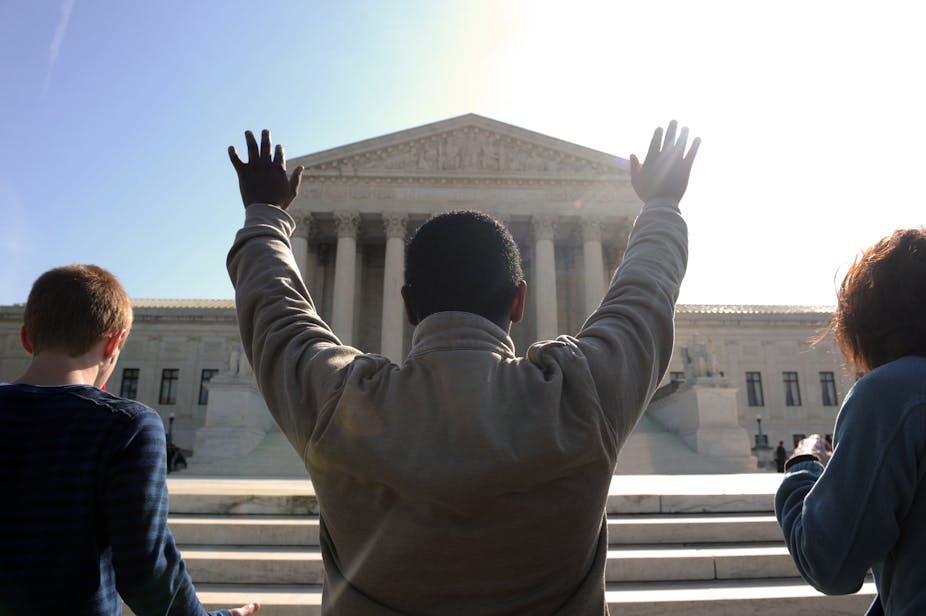The demise of the Christian right has been prophesied on numerous occasions, but it’s never come to pass. Far from it: with the Trump administration taking shape, the movement is prepared to take power and exert influence at the top of government as never before.
This was not preordained. In one of the biggest gambles they’ve taken in years, the Christian right’s ageing leaders turned away from presidential candidates more aligned with their politics to strike a Faustian pact with the all-too-worldly Donald Trump. The bet threatened to split the movement, but in the end, it paid off, and Trump now owes Christian conservatives big for turning out and backing his campaign. And if his cabinet appointees are anything to go by, his administration is preparing to pursue an agenda the Christian right has been pushing for years.
Mainly but not exclusively comprised of white conservative Catholics and evangelical Protestants, the movement’s stated aims are to defend and advance values threatened by a rapidly transforming society, among them the “traditional family”, prayer in schools, small government, and fiscal conservatism. It stands opposed to pornography, promiscuity, abortion, LGBT rights, and the long-mooted equal rights amendment, designed to guarantee equal rights for women.
Rather than pursue its ends as an outside pressure group, the movement organised itself into a political force, getting behind the Republican Party in particular. Its leaders and footsoldiers helped secure Ronald Reagan’s 1980 presidential victory, and its agenda has played a key role in American politics ever since. Around 26% of the US electorate self-identify as white evangelicals, and their votes are now a crucial part of the Republicans’ electoral coalition.
In recent election cycles, though, the connection between the movement and the party has frayed. While the presidency of conservative evangelical George W. Bush was a high point for the Christian right, no bona fide conservative Christian Republican candidate has attracted overwhelming support from the movement, which has no single recognised leadership or formal structure.
Instead, white evangelical Republicans have ultimately backed the candidate they felt had the greatest potential of defeating a Democrat. In 2008, Mike Huckabee was rejected for John McCain; in 2012, Catholic Rick Santorum and Conservative evangelicals Rick Perry and Michele Bachmann were rejected for Mitt Romney, a Mormon. Both nominees were defeated by Barack Obama.
The same dilema was presented in 2016. Conservative Christian voters had to get behind a candidate who could defeat their longtime bête noire, Hillary Clinton, while remaining at least sympathetic to their views. As in previous races there were strong conservative evangelical candidates on offer, in particular Ted Cruz, who had a 100% voting record on values issues in the Senate and who won the straw polls taken at the Values Voter Summit three years in a row.

But for all his impeccable evangelical credentials, Cruz was and still is enormously disliked even by most Republicans for his perceived cynicism and grandstanding; John Boehner, former speaker of the House of Representatives, described him as “Lucifer made flesh”.
This left an opening for Trump, at least at the top of the movement. Despite his flamboyant lifestyle, dubious business background and predatory misogyny, he was nonetheless backed by key figures within the Christian right who identified his potential surprisingly early on.
Jerry Falwell Jr, a key movement figure, summed up their rationale:
For decades, conservatives and evangelicals have chosen the political candidates who have told us what we wanted to hear on social, religious, and political issues only to be betrayed by those same candidates after they were elected.
Realising this would be a two-way street, Trump courted the movement from the outset.
A relationship with Him
He positioned himself as a Christian, albeit one who had never found the need to ask God’s forgiveness. In his 2015 book Crippled America, he wrote:
I think people, are shocked when they find out that I am a Christian, that I am a religious person. They see me with all the surroundings of wealth so that they sometimes don’t associate that with being religious. That’s not accurate. I go to church. I love God, and I love having a relationship with Him.
Trump made all the right promises: to restore, cherish and protect the nation’s Christian heritage, to appoint anti-abortion justices to the Supreme Court, and to repeal the Johnson Amendment which prohibits tax-exempt organisations from endorsing political candidates. He told Values Voters at their 2016 summit that: “There are no more decent, devoted, or selfless people than our Christian brothers and sisters here in the United States.”
Trump also brought Christian right leaders formally into his campaign, setting up an evangelical and Catholic advisory bodies and filling them with movement stalwarts. Above all, he chose as his running mate Indiana Governor Mike Pence, a leading campaigner for value issues who describes himself as “a Christian, a conservative and a Republican, in that order”.
Not everyone was pleased. A number of prominent evangelicals worried that dallying with Trump would fatally damage the movement’s credibility, given his chequered past and his attitudes towards Mexicans, Muslims and women. This opposition grew with the release of the Trump Tapes revealing his predatory attitude and actions towards women. But none of this seriously diminished the resolve of Trump’s evangelical backers, who were content to stay the course in pursuit of worldly power.
In the end, white evangelicals came out to vote in greater numbers than ever before, and 81% of them backed Trump on November 9.
Trump clearly intends to return the favour, and is already appointing leading religious conservatives to key cabinet posts. As far as the organised Christian right is concerned, it doesn’t get much better than this. Their movement is back, bigger and bolder than ever. In Trump’s own words: “And you believe it. And you know it. You know it.”

